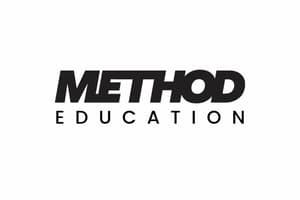Podcast
Questions and Answers
What is the primary function of the global dynamic muscles?
What is the primary function of the global dynamic muscles?
- Stabilize the low back and pelvis
- Create intra-abdominal pressure
- Produce large amounts of torque and gross movements (correct)
- Control intersegmental motion
Which muscle is responsible for creating intra-abdominal pressure to support the spine from within?
Which muscle is responsible for creating intra-abdominal pressure to support the spine from within?
- Rectus Abdominus
- Quadratus Lumborum
- Erector Spinae
- Transversus Abdominus (correct)
What is the main responsibility of the diaphragm in relation to the core?
What is the main responsibility of the diaphragm in relation to the core?
- Spinal rotation and lateral flexion
- Maintaining an upright position
- Creating intra-abdominal pressure (correct)
- Spinal flexion and lateral flexion
What is the primary role of the quadratus lumborum?
What is the primary role of the quadratus lumborum?
Which muscle group is responsible for spinal extension, lateral flexion, and maintaining an upright position?
Which muscle group is responsible for spinal extension, lateral flexion, and maintaining an upright position?
Which muscle connects the pelvis to the thoracic cage and provides general stabilization to the area along with trunk movement?
Which muscle connects the pelvis to the thoracic cage and provides general stabilization to the area along with trunk movement?
What muscle is traditionally known as the 'core muscle' and attaches directly to the lumbar vertebrae?
What muscle is traditionally known as the 'core muscle' and attaches directly to the lumbar vertebrae?
Which muscle is responsible for controlling intersegmental motion, responding to changes in posture and extrinsic loads?
Which muscle is responsible for controlling intersegmental motion, responding to changes in posture and extrinsic loads?
Which muscle group consists of 'slow-twitch fibers' and is responsible for stabilizing the low back and pelvis?
Which muscle group consists of 'slow-twitch fibers' and is responsible for stabilizing the low back and pelvis?
What is the primary responsibility of the local postural muscles?
What is the primary responsibility of the local postural muscles?
What type of muscle fibers do the global dynamic muscles possess?
What type of muscle fibers do the global dynamic muscles possess?
What does the transverse abdominus primarily help create to support the spine from within?
What does the transverse abdominus primarily help create to support the spine from within?
Which muscles are included in the muscular box described as the core?
Which muscles are included in the muscular box described as the core?
What is the term commonly used to refer to the ability of the core muscles to stabilize the lumbar spine and pelvic girdle?
What is the term commonly used to refer to the ability of the core muscles to stabilize the lumbar spine and pelvic girdle?
Which type of exercise is specifically mentioned in the context of 'CORE STABILITY EXERCISE'?
Which type of exercise is specifically mentioned in the context of 'CORE STABILITY EXERCISE'?
How many pairs of muscles help to stabilize the spine, pelvis, and kinetic chain within the core muscular box?
How many pairs of muscles help to stabilize the spine, pelvis, and kinetic chain within the core muscular box?
Flashcards are hidden until you start studying
Study Notes
Global Dynamic Muscles
- Primary function is to produce movement and generate force during physical activities.
- Comprised of muscles that work together for dynamic and coordinated movement patterns.
Intra-abdominal Pressure
- The transverse abdominis is responsible for creating intra-abdominal pressure to support the spine from within.
Diaphragm Role
- Main responsibility of the diaphragm is to regulate breathing and assist in core stability during inhalation and exhalation.
Quadratus Lumborum
- Primary role includes stabilizing the pelvis and lumbar spine, facilitating lateral flexion of the spine.
Spinal Erector Muscles
- Muscle group responsible for spinal extension, lateral flexion, and maintaining an upright position; includes the erector spinae.
Pelvis to Thoracic Cage Muscle
- The multifidus connects the pelvis to the thoracic cage, providing stabilization and aiding in trunk movement.
Core Muscle
- The psoas major is traditionally known as the 'core muscle' and directly attaches to the lumbar vertebrae.
Intersegmental Motion Control
- The multifidus helps control intersegmental motion, adjusting to changes in posture and variations in external load.
Slow-Twitch Fiber Muscle Group
- Local stabilizer muscles, consisting of 'slow-twitch fibers', are responsible for stabilizing the low back and pelvis during static and dynamic activity.
Local Postural Muscles
- Primary responsibility is to maintain posture and stabilize the spine during movement.
Muscle Fiber Types
- Global dynamic muscles possess fast-twitch fibers, designed for quick and powerful movements.
Transverse Abdominis Function
- Primarily helps create intra-abdominal pressure crucial for spinal stabilization and support.
Core Muscular Box Composition
- Muscular box includes the diaphragm, pelvic floor, transversus abdominis, and multifidus, all contributing to core stability.
Core Stability Terminology
- Term commonly used to refer to core stabilization is "lumbar stabilization."
Core Stability Exercises
- Specific exercises mentioned for enhancing core stability include planks, bridges, and rotational movements.
Muscle Pairs for Stabilization
- A total of 31 pairs of muscles contribute to stabilizing the spine, pelvis, and the kinetic chain within the core muscular box.
Studying That Suits You
Use AI to generate personalized quizzes and flashcards to suit your learning preferences.




